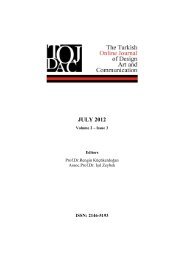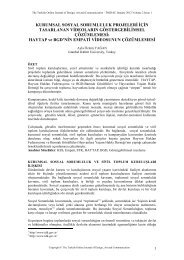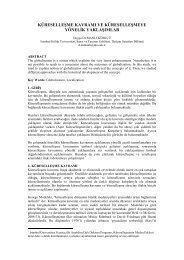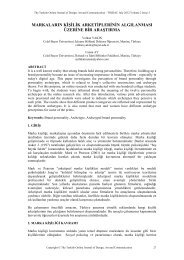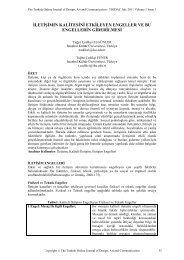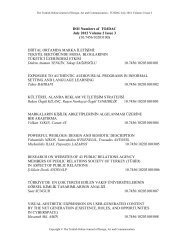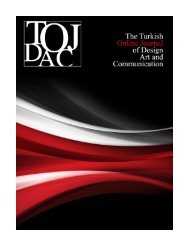aprıl 2012 - tojdac.org
aprıl 2012 - tojdac.org
aprıl 2012 - tojdac.org
You also want an ePaper? Increase the reach of your titles
YUMPU automatically turns print PDFs into web optimized ePapers that Google loves.
The Turkish Online Journal of Design, Art and Communication - TOJDAC April <strong>2012</strong> Volume 2 Issue 2<br />
previously been possible, resulted in much-improved image quality. The optical printer also<br />
found favour in the production of many 1930s musicals whose spectacular dance sequences<br />
needed flamboyant scene transitions, such as the star-wipe and the now iconic spinning<br />
newspaper effect.[8]<br />
3.3. The Digital Age<br />
In the late 1950s and into the 1960s, John Whitney, Sr., began creating intricate and involving<br />
images using surplus analog military equipment. He photographed moving patterns of light<br />
and lit objects that were moved by these analog computers. The patterns recorded by a camera<br />
synchronized to the motion were intricate and complex. This work was the inspiration for the<br />
slitscan technique used to create the stargate sequence in the film 2001 (1968). Followed by<br />
this many visual effects artists scientists, computer engineers and companies entered the race<br />
of developing visual effects.<br />
Major advancements in computing speed, power, and storage led to the creation of tools to<br />
record and then film out scenes captured by motion picture cameras. Visual effects facilities<br />
and visual effects and special effects artists and scientists used imagination, technical<br />
knowledge, and an amazing amount of creativity to invent and create these first tools. In the<br />
late 1980s Kodak, with collaboration from ILM, developed the technology for the first (more<br />
or less) practical film resolution scanner. Along with this invention came the development of<br />
the Cineon digital film format, which became the standard format for motion picture image<br />
recording and filming across the world.<br />
In 1988 audiences were excited by the use of digital “morphs” in Willow. The Abyss, with its<br />
water character, and Terminator 2, featuring a fully CG leading man, opened 'in 1991. In 1992<br />
the first attempt was made to replicate real, recognizable creatures in a feature film the<br />
penguins and bats in Batman Returns.<br />
The years since 1993, it can be argued, included as much innovation as the previous 100 years<br />
of visual effects. Everything was open, and a legion of incredibly clever visual effects artists,<br />
scientists, and engineers redrew the landscape such that no effect was beyond our reach. We<br />
saw the world of optical printing fade from common use faster than any of us would have<br />
believed possible as digital scanners and printers, augmented by new compositing, 2D<br />
software, and fantastic developments in 3D camera and object tracking came to the fore. [9]<br />
4. THE VISUAL EFFETS TECHNIQUE<br />
Many of the conventional techniques are still in use even after the digital era, changes were<br />
made and improvements while others were replaced by digital components.<br />
4.1. Conventıinal Techniques In Categories<br />
The technique of visual effects cinematography improved over the years by many technicians<br />
and inventors, if we have a look at the conventional visual effects before implementing digital<br />
techniques; we will see that some of the effects were done by the cinematographer in the<br />
location other techniques were mainly lab process and optical printing work and sometimes a<br />
combination of the two techniques:<br />
1- In the camera effects: in which all of the components of the final scene are<br />
photographed on the original camera negative:<br />
A. Basic effects<br />
1- Change in object speed, position or direction.<br />
2- Image distortions and degradations.<br />
3- Optical transitions.<br />
4- Superimpositions.<br />
5- Day- for- night photography.<br />
B. Image replacement.<br />
Copyright © The Turkish Online Journal of Design, Art and Communication 117



